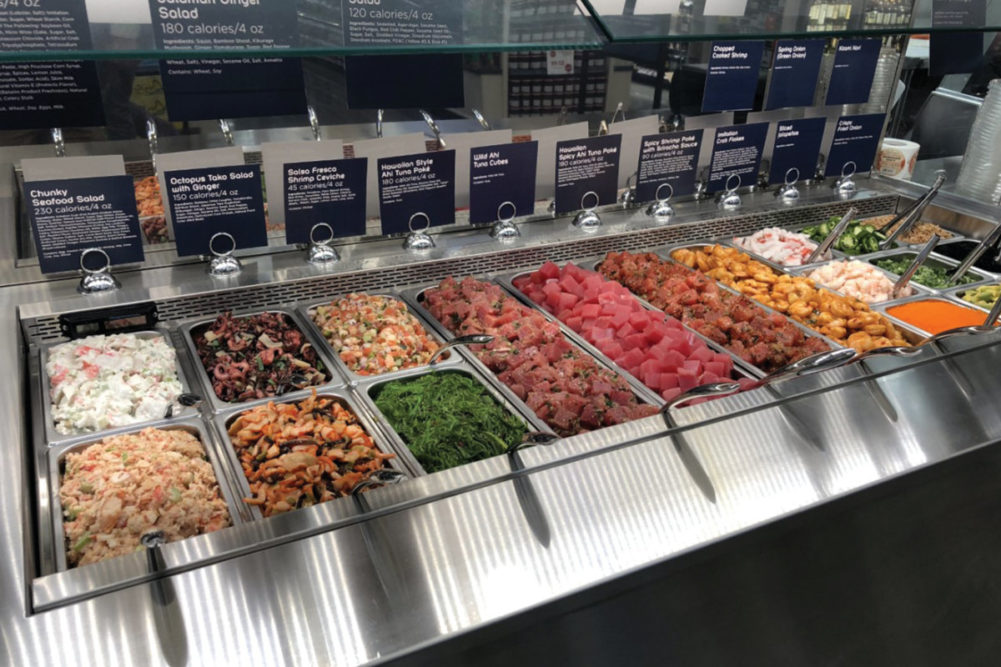KANSAS CITY — After being hit hard by COVID, instore dining and other grocery foodservice options within the fresh perimeter are coming back —and strong future growth is anticipated.
This summer, Encino, Calif.-based retailer Gelson’s fully reopened all of its self-service instore dining destinations: salad bars, hot bars and soup and chili bars.
The company has also reopened its wine and tapas bars, which share the same seasonal menu themes as the rest of the offerings produced by its Gelson’s Kitchens division.
Gelson’s also sells Wolfgang Puck pizzas and salads in its Wolfgang Puck Express and Kiosk locations. And in late July, the company unveiled its first standalone sushi bar, at its reopened store in Irvine, Calif.
The revamped store also includes refreshes of Gelson’s popular self-serve soup, salad and poke bars and a craft beer and tapas bar.
And more dining options for Gelson’s customers are in the works, said Abe van Beek, corporate executive chef for Gelson’s Kitchen Support Team.
“We have a new catering program and website in development and are still helping our customers provide wonderful events with the Gelson’s Kitchen help,” he said. “We do the work and you take the credit.”
Covid-19 changed the way people shopped, especially in freshly prepared items, van Beek said. And the pandemic made the Gelson’s Kitchen offerings that much more important to customers who couldn’t or were hesitant to go to restaurants.
“That combination enabled us to re-engineer and re-focus how we can continue to support our customers and continue to provide them a vast selection of freshly prepared food items, covering many ethnicities and all dayparts,” he said.
Gelson’s has retooled its menus to maximize efficiencies and profitability, while also improving and cleaning up ingredients for a more balanced nutritional focus.
The Kitchen division also leans heavily on the support of its other store departments — for example, leveraging its meat department’s relationship with Certified Angus Beef, and its best in class fresh produce offerings.
“These efforts assisted in us being able to quickly adapt and recapture sales that we had lost from some sub-department closures,” van Beek said.
Recovering from the pandemic is an ongoing process, he added. Gelson’s takes an aggressive stance: they want its customers to feel like they need to come back to the store to check out the latest offerings, and renew their love of old favorites, from the Gelson’s Kitchen.
One of the ways the company does that is by constantly refreshing its menu. Van Beek points to the retailer’s popular seasonal menu, which rotates every quarter and takes advantage of all of the produce grown locally in Southern California.
The biggest trends in instore dining and grab-and-go dining options include freshness, quality and international offerings, van Beek said.
Report: grocery foodservice set for strong growth
Retailers would be wise to look at beefing up their instore dining options to enhance their perimeter bottom lines, according to the latest Power of Foodservice at Retail report from the Arlington, Va.-based FMI – the Food Industry Association.
FMI’s sixth annual analysis of retail foodservice provides a comprehensive review of shoppers’ perceptions and behaviors regarding prepared foods in grocery and underscores the implications for the industry to capture and expand its pre-pandemic share of the total food dollar.
“Grocery foodservice is at a competitive inflection point when we look at the state of the U.S. food dollar and the fact that 59% of Americans expect to cook as many meals at home as they do now,” said Rick Stein, FMI’s vice president of fresh food. “The analysis suggests grocers are positioned to be the ultimate mealtime solution in that 39% of consumers view retail foodservice as a substitute for a both a home-cooked meal and a restaurant meal.”
Three significant themes emerged out of the survey, which was prepared by 210 Analytics and made possible by Hussmann Corporation and Produce Marketing Association.
- Visibility at Retail: More than one-third of consumers, up slightly from 2019, do not recognize their local grocer as a foodservice option due to a lack of menu choices. The report underscores opportunities for increased visibility through marketing and merchandising strategies – all while acknowledging the growing time constraints and cooking fatigue among shoppers to prepare a convenient and nutritious meal. To further promote engagement, shoppers emphasized their desire for retailers to highlight nutrition facts and meal ingredients.
- Hybrid Meals Support Shoppers: The analysis notes that shoppers are looking for comprehensive meal solutions, not just prepared items. In fact, 55% of those surveyed note a desire for hybrid meal options – or those that are a mix of semi-and-fully-prepared items. It is noteworthy that 64% of consumers who typically prepare hybrid meals say they plan their dinners a few days at a time.
- Convenience Enabled by Technology: Technology supports shoppers’ strong desire for convenience with more than half of consumers expressing a desire to order deli-prepared items with a smartphone. The survey also points out significant disparities among generations in how they want to engage in retail foodservice ordering. For example, 20% of Gen Z customers prefer ordering from a person versus using their own phone (49%) or a kiosk (31%), compared with 89% of Boomers who prefer ordering from a person.
“Grocers confidently acknowledge the power in convenience-driven retail foodservice, as these programs continue to serve as differentiation strategies for their businesses,” Stein said. “As evidenced in this analysis, with the right formula that caters to the customer with supportive technology, food retailers can increase their significance as a destination for health, well-being and meal solutions.”
Keep up with the latest in deli and prepared foods.

